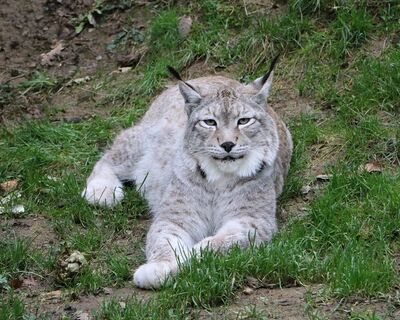Jungg'o Lynx
| Jungg'o Lynx | |
|---|---|

| |
| Image of the Jungg'o Lynx resting in the Omiskan Central Animal Garden | |
| Scientific classification | |
| Kingdom: | |
| Phylum: | |
| Class: | |
| Order: | |
| Family: | |
| Genus: | Lynx
|
| Species: | J. Lynx
|
The Jungg'o Lynx (Lynx lynx Junggeli), also known as the Central Hiakemirian Lynx, is a subspecies of the Hiakemirian Lynx found primarily in Jungg'o, Neo-Korea, and other regions bordering those areas. They live primarily in the Sukpia Range and north of the Central Jungg'o River. It is the most common subspecies of the Hiakemirian Lynx, and is notable for living to an approximate age of 25 on hypothetical average, although a majority do not live to a greater age than 20. It is a notable subject for Neo-Korea's limited conservation efforts, being prominently featured in the Omiskan Central Animal Garden. It is threatened by prey depletion and human agricultural encroachment in Jungg'o.
It is considered a minor national symbol for the Free Jungg'o Movement, and appeared on several coins created by the Republic of Jungg'o before the cessation of the state's existence.
Description
The Jungg'o Lynx is relatively average in size for a subspecies of the Hiakemirian Lynx, although it possesses more notable facial tufts, paws designed to allow for movement on snow and anchoring to the rocks making up mountains, thick fur, and many variations on the number of spots they have the potential to possess, allowing for very identifiable individual specimens. They generally tend to have bobbed tails, and their fur is usually a light brown or white with dark stripes. As a subspecies of the Hiakemirian Lynx, it is larger than non-HL subspecies.
Behavior
Jungg'o Lynxes act primarily as ambush hunters, being solitary amongst their own breed and avoiding human contact in the majority of situations. They mark their territory through specialized glands, with females claiming a larger territory than males - although both genders will only allow for the presence of one other breeding member of their species in the same area. Parents and children can have overlapping territory, although predilection of the species for isolation remains even in this situation.
Prey and Predators
The Jungg'o Lynx primarily consumes Hares, Pikas, and other small mammals - although they also target Birds, Deer, Kurokikune, and Sukabegu. As hunters, they regularly steal the kills of other animals, avoiding conflict but regularly trying to scavenge for materials if possible. They are sometimes eaten by the Hiakemirian Gray Wolf if caught unprepared, with the Wolves being able to climb up trees to assault Lynx ambush positions.
Breeding
Mating season is from August-October, with males and females feeding together and crossing territories during this period. During this time, they will attempt to see if mating is a viable action, and if it is they will raise a litter of approximately 2-5 kittens. A newborn lynx is cared for by both parents for about twelve months or one year, until they are deemed independent enough to be let out of the den to begin personal hunting. As mentioned above, the kittens will often choose a location located near their parents, for reasons which are currently unknown owing to their general attempts at isolation from one another.
Conservation
The Jungg'o Lynx is created a Vulnerable species, and breeding programs are often carried out at the Omiskan Central Animal Gardens, and native territories for the lynx have presences designed to defend from poachers. Multiple breeding populations exist in Neo-Korea, and it is believed that presuming no major issues occur, there will be a renewed population by 2036, although education efforts have focused on the need to keep supporting them beyond this point.